#psychogeographic
Text

#psychogeography#urban landscape#street photography#urbanphotography#walkingphotography#urbandecay#new topographics#new topographers#southern california#minimalism#fujifilm#psychogeographic#inlandempire#shadow#alteredlandscape
79 notes
·
View notes
Text



The Italian Chapel consists of two Nissen huts transformed into a beautiful chapel by Domenico Chiocchetti and his colleagues, Italian prisoners of war captured in North Africa and transported to the Island of Lamb Holm in Orkney.
In October 1939 a German submarine under the command of Gunther Prien entered Scapa Flow and sank the British battleship 'HMS Royal Oak' with the loss of 834 lives. Winston Churchill, at that time First Sea Lord, visited Orkney and the decision was taken to construct barriers to close off four of the entrances to Scapa Flow to make the base for the home fleet more secure.
A shortage of manpower to construct the barriers coincided with the capture of thousands of Italian soldiers fighting in North Africa, so a decision was taken to transport 550 men to Camp 60 on Lamb Holm and a similar number to Camp 34 on Burray.
Following a request from the camp priest, Fr Giacobazzi, it was agreed that two Nissen huts would be joined together to provide a chapel. Among the Italians in Camp 60 was an artist, Domenico Chiocchetti, and he was given the task of transforming the two Nissen huts into a chapel. He was assisted by other tradesmen - in particular Giuseppe Palumbi, a blacksmith, and Domenico Buttapasta, a cement worker.
Domenico Chiocchetti carried in his pocket a small prayer card given to him by his mother before he left his home in Italy, and it was the image on that card of the Madonna and Child by Nicolo Barabino that Chiocchetti based his painting above the altar in the Chapel. When the Camp Commander, Major Buckland, realised that the prisoner was a very talented artist he was allowed to continue painting to make the building more attractive.
Now, decades after the completion of the Chapel, it is one of Orkney's most loved attractions, with over 100,000 visitors every year.
Source:
0 notes
Text
Drawn to the Edges
Drawn to the Edges: the one where I finally talk about what I have dubbed the Edges and others The Edgelands
Six-thirty am Sunday 25th September. It was a late night last night but despite this I was awake in a Reading hotel room, feeling tired yet ready to start a new day. As it was likely that I’d be the only person up and about for a while I dressed and left the hotel for a wander. No plan as such although I wasn’t going to stray too far from our hotel not least in case the wife woke and wanted an…

View On WordPress
0 notes
Text
Sunken Lands: A Journey Through Flooded Kingdoms and Lost Worlds by Gareth E. Rees: Book Review
Sunken Lands, the new book by Gareth E. Rees may be one of those that forms a quandary for bookshop staff – just what shelf should it be placed on? For within its pages it covers a wealth of terrain (mostly of the moist or entirely saturated variety). Is it a folklore and legend book? A travel and history book? Psychogeographical philosophy? Natural History/Conservation? Occulture and Mystery?…

View On WordPress
14 notes
·
View notes
Photo
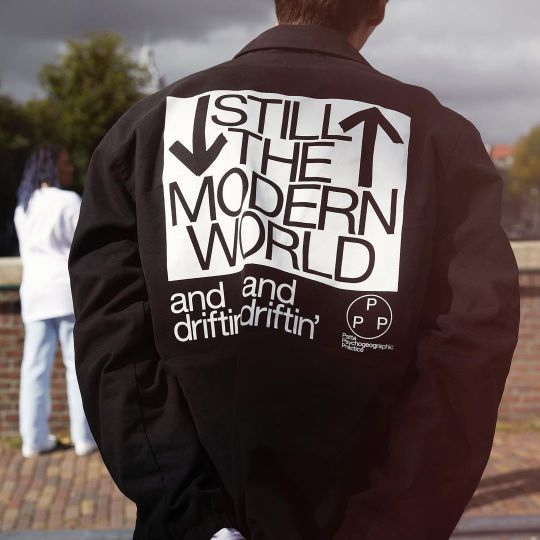
Patta Psychogeographic Practice
125 notes
·
View notes
Text



Went to hospital the other night and it activated the psychogeographer. Bit of a fucking bizarre and intriguing experience.
8 notes
·
View notes
Text
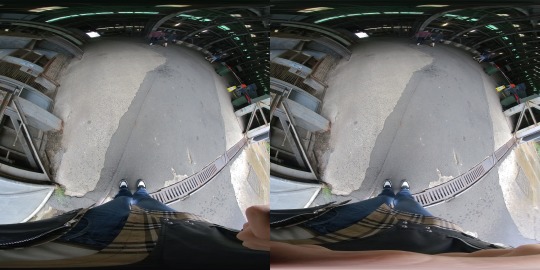
Insta360 Evo using experience
This was my first time using this model of camera to make a video, and the process from choosing the shooting location to the actual shooting was very interesting. I continue to explore unknown space and time, try to establish a psychogeographical connection with them, and slowly perceive them.
2 notes
·
View notes
Text
i would love to write an essay exploring wuthering heights as a psychogeographical folk horror ...
22 notes
·
View notes
Text
Assignment for one of my classes involves me doing a floorplan/map of my flat, but through a more subjective, maybe psychogeographic lens
and this coincides with me learning architectural feng shui principles let's gooooo
29 notes
·
View notes
Text
Situationism and the psychogeographical view of cities my beloved
2 notes
·
View notes
Text
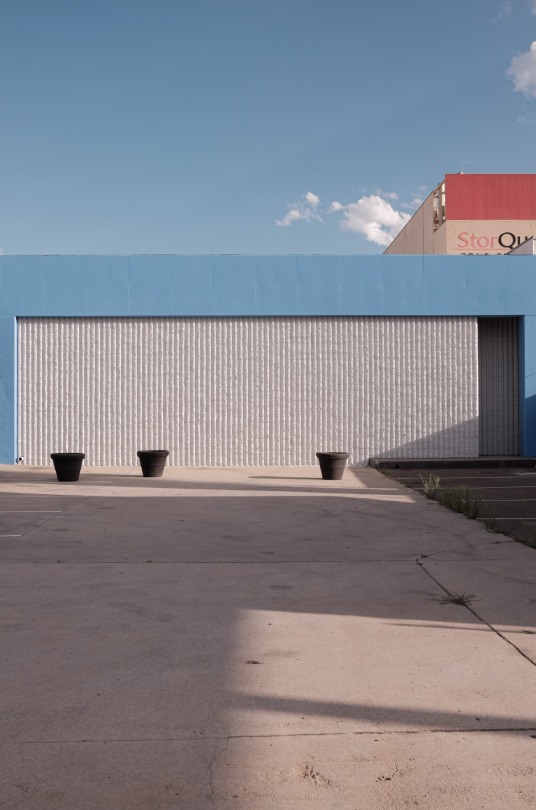
#psychogeography#urban landscape#street photography#urbanphotography#walkingphotography#new topographics#new topographers#southern california#minimalism#fujifilm#psychogeographic#architecture#urbanism#hollywood#colorblock#los angeles
123 notes
·
View notes
Text
I am fascinated by how over the next few decades we will probably get a whole new queer community, of the now-adult kids of queer parents.
I remember having ONE friend who had two lesbian Mams when I was a teenager, who didn't even go to the same school as me. And his Mammy and Mam had been in the local paper because of being denied IVF to have a second child - And the article included disgust and horror that they had a FIRST child, conceived the old-fashioned way. There was a week of readers' letters talking about how he should have been taken away from them.
So, he was basically alone in having the experience of being raised in queer community, even though he had plenty of gay friends, and as time wore on we met a few more people where one of their parents had come out late in life and they now had one gay parent, a gay stepdad or stepmam, but also still with one ostensibly straight parent too. But now, I feel like the first generation where a kid with two out gay parents who are both their parents has had the chance to know other kids-of-gay-parents when they were growing up, and to make a cohesive culture together.
Second- and third- generation queer people are going to have experiences and identities that I can't even fathom. My friend (Not the one with Mam and Mammy, but one whose Mam came out when he was in infants school and never got him a Stepmum, but who took him to all kinds of Dyke events and fully socialised in Dyke norms) grew up to be a lesbian, sort of- He was so embedded in lesbian culture, he only ever had relationships with bi dykes and ended up handfasting with a Butch and very much embracing being a Femme as part of that. Straight dating and straight sexual politics just totally lost him.
And now as an adult, know a few more people of all orientations who were raised by gay parents, and whether or not they think of themselves as queer seems to not be determined by their orientation but by something way more complicated. And I wonder how that will shake out over the next decades, will we as a whole embrace "I'm gay, both Dada and Tato are gay, and my four grandmothers are lesbians, it doesn’t matter that I'm heterosexual, I am also GAY." or will they be seen as (and largely see themselves as) straight people like any other straggot? Will it be less of a whole thing as gay couples move more in straight society too rather than in gay villages (whether physical or psychogeographical) and the cultural gulf between our societies narrows?
I am just excited to see!
2 notes
·
View notes
Text
if we assign some psychogeographic dimension to the house then arthur and tommy having the conversation in the cellar (where tommy sheds light on arthur as he enters, where the barrels are filled with blood, where they talk of the boat they lived on and of a tunnel they went through as children) you'd inevitably think about the subconscious/unconscious; it would make sense to consider what they talk of as both literal and symbolic, and that there's always a potential of things Not Being Spoken Of, intentionally or due to a lack of consciousness or a lack of language, that there are some things still to remain in the dark for now.
simultaneously, in the beginning of the season lizzie says 'father christmas/arthur is up the chimney' ie he's high on heroin, and the chimney is incidentally where ruby's grey man is coming from - that being this figure a certain anxiety is projected on by tommy
4 notes
·
View notes
Text
Urban Furniture
Urban furniture is an important part of the lives of those of us who exist in urban environments. It is easy to ignore urban furniture and let it shape us, but to do so is not only boring, but foolish.
What Is Urban Furniture?
For our purposes, urban furniture will refer to the collection of physical features deployed in the public environment and oriented towards pedestrian activity for the purposes of providing or removing amenities. This definition is flexible and there is not much point in worrying about the edge cases. Pedestrian versus vehicular activity is the most significant boundary. The difference between a person in an automobile and a pedestrian is large, both in what they can do and how they behave, and we don't want to care about amenities for automobiles, which occupy an entirely different world, hostile to everyone else. Bicyclist versus pedestrian activity is a smaller leap, especially because a cyclist can change into a pedestrian and back easily. And then, with scooters, wheelchairs, and other mobility devices, the lines are blurry. Similarly, public and private space can intersect; an accessible space might be considered public but exclude enough freedoms to make the designation questionable, for example by requiring but not enforcing payment, or by denying freedom of expression.
What Are The Goals Of Urban Furniture?
Objects themselves have no purpose, of course. Their purpose comes from how and why they are deployed and used. What is the purpose behind installing urban furniture? Is it help or harm individual people? Yes, but more importantly, it is to help, harm, or influence populations.
Urban furniture provides or denies an amenity, essentially granting or removing an ability. It can allow rest with a bench or wall, give shelter with a roof, wall, or bollard, assist movement with a sidewalk, ramp, stairs, or handrail, or provide other resources such as a hitching post, heat, or water. It can distribute items, for example a newspaper box, ATM, rental bike rack, or vending machine. It can facilitate communication with a telephone, speaker, sign, or other content distribution method. And it can enable expression with services like a graffiti wall, amphitheater, or public square. It can deny rest with anti-sit and anti-lie devices or other obstructions, and it can deny movement with walls, railings, anti-skateboarding devices, or turnstiles.
Often, urban furniture might modify or encourage where an amenity can be accessed. A tree can be protected from pedestrian wear with a paved walkway that provides an easier path at a suitable distance. The mechanism used might not be completely physical, using communication such as markings or sounds that guide interactions between people, or assist the enforcement of rules by a separate class of people in police or security roles. In this way, the goals of urban furniture can be seen to be behavior modification.
How Should We Understand Urban Furniture?
The urban furniture around us should be considered with a psychogeographic approach. Notice what affordances are being given and taken away, and what behavior those changes are promoting or discouraging. How does it change the relationships between people, and between people and their environment? How does it shape the human society around it, and change the mood of the neighborhood and its occupants? It can also be helpful to explore the ecosystem of processes behind the deployment of urban furniture. What are the systems that cause it to end up where it is? How long are the bureaucratic supply chains behind it, and what are the conflicts between objectives which affect the placement and removal of urban furniture?
As pedestrians, we are the subjects of urban furniture, it is our behavior being modified. In the long term, our outlook is also being modified, as we respond to our environment and gradually alter what we consider to be possible and desirable. Do we think it is weird to pay a fare before entering a subway platform, or not be able to lie down in public, or only discard trash in a receptacle? Is it normal to loiter and interact with other people? While we may have exhibited some of these behaviors regardless, the help or hindrance provided by the built environment, amplified by the effects of observing how it is used by the people around us, influences many of our actions and even our desires.
Examples of urban furniture analysis
Pretend Benches

At the first look, this might be described as an actual piece of furniture. It presents as a bus stop bench, designed to allow the human body to rest while waiting for a bus.
What affordances are really provided or denied by this item? Its shape shows one which is only slightly subtle. It has a tilted surface at waist height for some people. Is it intended to provide support, for people to snug their butts on the surface to lean against it? No, it is not. Nobody has ever done this. The resting surface is merely cosmetic, to provide the illusion of an amenity. It is meant to appear to be a minimum viable bench even though it is completely unsuitable for that task.
The most important aspect is the vertical surface. It is a billboard. Why is there a fake leaning surface at all? Because the bus company can say that the primary purpose of this item is for passengers to rest on while waiting for a bus. There is a design requirement that must be followed for this item to exist here.
Why is this billboard important? The bus company gets income by renting it out to advertisers. This also requires more behavior modification. Ordinary people are not allowed to decorate the billboard, only the advertisers approved by the bus company may. We might want to improve its message or replace it with our own, but we may not. In this case, the physical characteristics of the item don't prevent us, but the related machinery of civilization does. If the police catch us altering it, we will be punished.
Of course, it was illegal to sleep on a bus stop bench long before someone invented this assault on our humanity, but it is much more efficient when physical characteristics prevent the action and enforcement isn't necessary. The iterations of this kind of design in attempts to allow sitting, but not reclining, make benches a favorite subject for students of hostile architecture. Also well studied are the many amusing examples of methods to circumvent these design elements. In the end, it has always been the police who are the final method of compliance. This fake bench doesn't require them, because it is impossible to lie on. All that was required was to make it useless as a bench.
It is interesting to deduce the processes behind it. Why not just remove the bench? Because that also removes the advertising, which is the whole reason for its existence. But what is the system that makes it even possible? The bus company can't just put a billboard there, otherwise we'd see panels of them at every bus stop. The city lets them advertise on benches because, hey, people get a bench, so the company is allowed to fund it with an ad. They need to pretend that this is a bench. But it is obviously not a bench. The designers knew that it would never be used as a bench. The city regulators knew. And they knew that we knew.
This is the core of psychogeographic inquiry. What does the built environment reveal about the priorities of those who deploy it? What are the expressed motivations and what are the real motivations? How do they mold us, as people and as populations?
Bollards
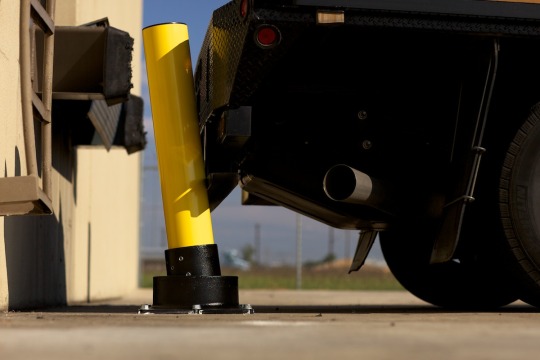
image distributed by IRSystems under the Creative Commons Attribution-ShareAlike 3.0 Unported License.
One of the oldest items of urban furniture is the bollard. Bollards can be seen all around the city, doing important work. Bollards evolved from mooring posts, and now serve as automobile area denial.
Look at any ATM or gas meter on a sidewalk vulnerable to ramming by a runaway or marauding car, and a bollard will be seen guarding it. The presence of a curb or a person is not enough. These bollards will be sturdy metal poles filled with concrete. Now visit a separated bicycle lane in America. You will not see the protection of a bollard. You may see Botts' dots, round domes a few inches high which give drivers a tactile warning as they swerve into the bike lane. Or you may see vertical traffic panels, flexible plastic pretend bollards designed to not damage the vehicles which strike them. What does this tell us about the values of hardware and humans? How does the escalation of the response to danger change with the source and target of that danger? How are we supposed to feel as people in these environments? Are we safe? Are we free? Can we be unguarded and open with each other?
Poles And Hitches
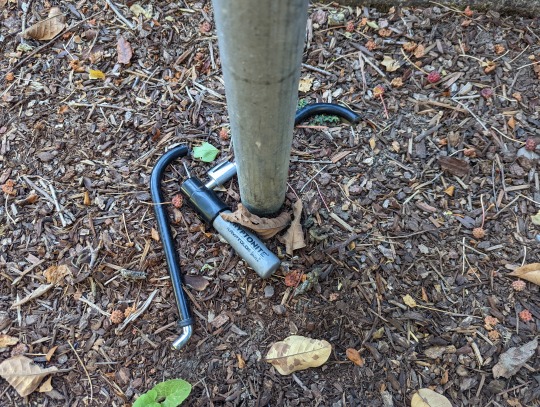
Poles are everywhere and are perhaps the simplest form of urban furniture, a stick to elevate something else. The way that they are used is what makes them interesting. They are appropriated as hitches, signposts, and a substrate for artwork. Explicit hitches are also used in this way. It makes a routine event fun. Locking a bike gives us a moment to see who has been there, and provides a visual sniff test of the neighborhood.

An important purpose of these objects is also protection from automobiles, a kind of single-use bollard. Because this is not their intended purpose - they are too expensive for that, their main reason for being goes away after they absorb an impact, and the humans they protect are not valuable - they often remain for a while after an impact until workers can be tasked to replace them. This allows them to fulfill another unintended purpose, a signal about the environment. You could be next!
Newspaper Boxes
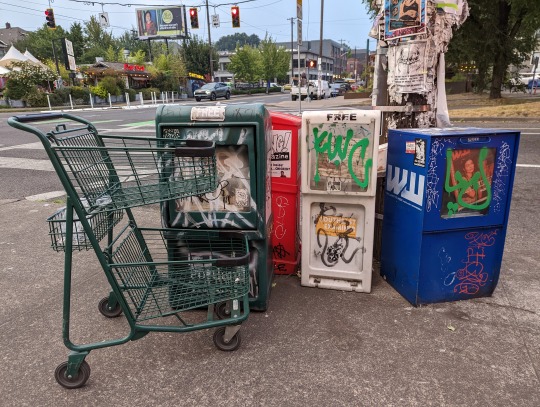
Newspaper boxes come in two varieties, coin-operated and free. Along with the intended purpose of distributing newspapers and pamphlets, they also create little coves of higher entropy where eddies of activity will deposit items. Shopping carts and items of landfill capitalism such as rental scooters can often be found in these zones, and of course smashed off pieces of cars.

Their lifecycle also often involves them being abandoned in place after they are no longer being filled, where they will remain as they are slowly bludgeoned into crumpled masses. All of these factors make them interesting zones of urban anthropology, where the detritus of a neighborhood can be examined. However, they also illustrate the sad human custom of stuffing trash in any space that will hold it. And any protected space may become a site for a tent or a makeshift shelter.
Writing Surfaces
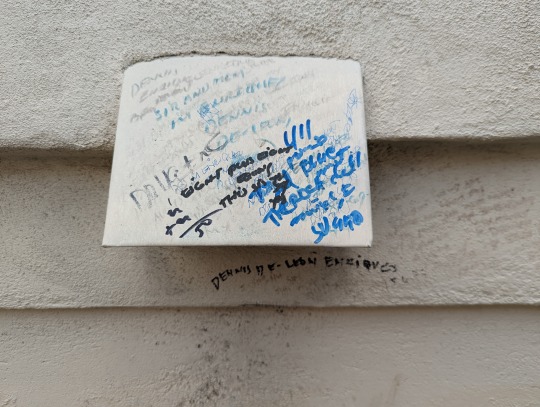
Urban furniture doesn't need to be intentionally placed as furniture. "The street finds its own uses for things". Any flat surface can become a place for notes to be written: graffiti, messages to specific people, or just as a kind of talking to oneself. It is interesting to see what the neighborhood is thinking about.
What Should Be Done About Urban Furniture?
We should, of course, gladly adapt our actions and values to accommodate those examples of urban furniture which are helpful and have a beneficial effect on our communities. And we must approach all urban furniture in the same way we do the rest of the urban environment, with playful intentions and actions. We must appropriate our surroundings in order to survive as individuals and as populations, and those of us who are able are obligated to do this with ludic engagement, by perverting functional directives into play structures.
Examples Of The Use Of Urban Furniture
Repurposing
Many items of urban furniture can be repurposed. Often, the systems which were allowed to originally place it will revert it back, but some subtle alterations go unnoticed for long periods, and even obvious ones will sometimes reveal that nobody who is supposed to be responsible is paying attention. Newspaper boxes are good targets because, as noted, they are just left lying around without much organization.

This box was turned into an art installation years or decades ago. It was moved into an out of the way side street, and it's just a remnant now, the rotating art show hasn't been updated for ages. Nobody is paid to care enough to remove it.
A more low-key change is to keep the original purpose of the device, but to replace the contents. Again, newspaper boxes are obvious candidates, more so during the golden age of copy shop exploitation and crackpot zine distribution, but still viable today.
With luck, the turf wars of that era can be revived. Some friends of mine once rebranded a vacant free newspaper box to give away their manifestos. After a period of successful distribution, they didn't refill it often enough and another group covered their signage with their own and took it over for their own zines, leading to some ironic complaining.
Additions, Improvements, And Alterations
It's always so nice to see that somebody has made the environment better for everyone. A handhold, a bootscraper, anything. A climbing rope in a fire escape, or a sketchy swing that is probably better left alone. And if not better, then at least different or confusing. Who is to say that an item bolted to one surface would not better serve the community bolted to a different one? Signs and other information sources can also be created or improved, wayfinding, notices and educational content can be placed. Rules, terms of service, legal boilerplate can be changed. Ideas workshopped, questions posed, color schemes rotated.
Games
The landscape of urban furniture can be made into a playground without anything other than the participation of one or more people, just by finding challenges. Physical contests can be invented on the fly anywhere, as anyone who is or was a child knows. Games can be created by adding rules or goals. Urban furniture can be used in unexpected ways, to see how creatively they can fulfill their original or new purposes, or just to see what assumptions can be broken without greatly changing the overall interactions. Routes can be followed to remain within or without the sight lines of types of installations. Stories can be built and expanded based on the engagements of unwitting passersby. By adding communication, other participants can be included without ever meeting. Chalk, stickers, or simply the placement and collection of objects can be used to communicate. Mazes can be drawn, puzzles eked out, and interactive guides can be grown.
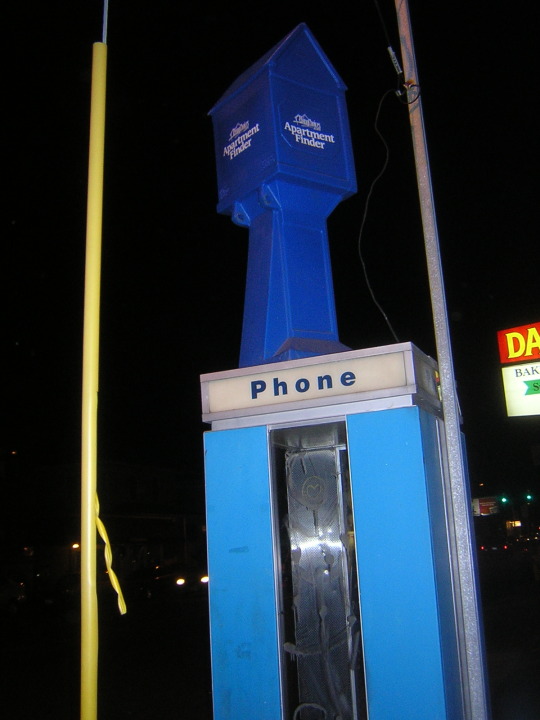
Any surface can be made into a challenge just by finding something difficult to do with it. The payphone near my house used to accumulate those stupid free commercial flyer boxes that littered the city. Walking home late one night, I thought they would look better if stacked. The newspaper box was empty and plastic, and all of its mass was in the weighted base. It turned out to be surprisingly hard to place it upright on top of the booth! It was taller than I could reach, so I had to toss it up there. It was easy to get the base to land, but if the pillar wasn't vertical, it would swing forward and back and fly off again. It became a fun test that amused me for a long time. Eventually, I gave up and began to walk away, only to hear a yell from an unidentified apartment nearby. "Don't give up! You can do it!" I waved in the direction of the voice and resolved to try again sometime, but a couple of days later, I found the box on top of the booth. My encouragers had succeeded where I had failed! Incidentally, this payphone was a COCOT, and the phone line was routed through the lamp enclosure, which can be accessed without breaking in or using specialized tools. Someone spliced a jack in there, so calls could be made for free by bringing a desk phone.
Adding Entire Instances
The city is full of features added by people and groups without permission, with good and bad motivations. It's incredibly fun and powerful to become the provider of urban furniture. Who's the boss now? But while the spirit of play might, if taken shallowly, encourage the practice of plunking down equipment and letting somebody else deal with it when it turns into street trash, this isn't sustainable for a long-lived project. The flip side is that the realities of maintaining assets and neighborhood relationships can be wearying. The behavior modifications we've been discussing don't just exist to turn people into docile sheep, they assist the maintainer's ability to keep the furniture available for all. To take the simplest example, flat horizontal surfaces are harder to maintain because people will leave their trash on them. It's easier to provide service if surfaces are tilted and won't hold items. Nooks and crannies will collect needles and cigarettes, alcoves may encourage activities better suited for other locations. In general, the lack of basic services provided by a callous society pushes some people into acting in unsustainable ways.
This is not to say that fun must be suppressed until all play is replaced by work. The balance must be found between propagating the ubiquitous smooth, secure, low-entropy facades of the cityscape, and giving people a little elbow room where they can decide to be socially redeeming even if some will not choose wisely. This hopefully encourages enough community support to avoid a wholly adversarial mindset.
Futel's Nefarious Role In The Ecosystem Of Urban Furniture
Futel's angle, of course, is to replicate and tweak structures that still have a few existing instances in the field. Why do we do this? To provide telephone service, of course, and to provide links to service providers over the telephone. And to provide radically accessible opportunities for pedestrians to interact creatively.
We are used to writing about this over and over again to drum up funding or outreach. It was more fun when we weren't as obvious about it, just putting down phones without any explanation, giving people something to discover and letting them wonder how many there were. The mere existence of our devices in a public setting is enough reason for us to place them, and luckily, we have found that they are still approached with curiosity. Do people doubt their memories when they see a new payphone? Do they invent strange backstories and weird organizations? Many do. More importantly, because our telephones cause some people to view their built environment with a critical eye, or make up stories and myths, or think about how they might participate, we know the project is extremely successful. We have a role in shaping not only the urban environment, but perceptions of the forms of the city and the forces behind them. And all we had to do was run a phone company for nine years.

16 notes
·
View notes
Text
The Drin — Today My Friend You Drunk The Venom (Drunken Sailor)

Today My Friend You Drunk the Venom by The Drin
If Cincinnati musician Dylan McCartney was named Kirk Stewart or Newton Thomas one might approach The Drin with a better idea of what to expect. Rather than sweet melodies and verbose poetry, McCartney and his cohorts work serpentine basslines, spindly guitars, dub rhythms, satisfyingly disruptive outbursts of noise and dystopic lyrics. These ten tracks take his city’s distorted garage punk legacy and connect it with a psychogeographical lineage that includes Sheffield, Dusseldorf, Bristol and Manchester. The result is a brilliant evocation of the rhythmic expansions that galvanized musicians straightjacketed by the conformity of punk.
Today My Friend You Drunk The Venom evokes mildewed post-industrial buildings under grey skies, dirty streets, thin black clad malcontents banging out their stuff with what comes to hand. The rhythms—everything from primal thump to rolling dub—take a central role in McCartney’s aesthetic. His words tumble out in a muttered monotone that does nothing to detract from the propulsion of bass and drums. Guitars flicker like guttering candles and squall like sheets of sleet against broken windowpanes. Everything is coated in reverb, and you can picture the fog of breath and steam of sweat as the band goes through its paces. The Drin summon the spirit of Warsaw on “Stonewallin',” Rocket From The Tombs on “Go Your Way Alone,” and they attack “Peaceful, Easy, Feeling” like a garage band backing Gregor Samsa, complete with the squawks of predatory birds (not The Eagles) rooting around rotting floorboards. Thing is, The Drin always sound like The Drin and that sound is very good. From the motorik rave of “The Day (Azoic)” to the Bristol influenced dub of “Eyes Only For Space” with clanking metallic percussion and twitchy guitar scratching in the background, McCartney’s gnomic declamations emerge from the murk to worm their way into one’s head.
The Drin cover a of lot bases here but connect the dots in a way that sounds both organic and logical. If Today My Friend You Drunk The Venom sounds like a record made by record collectors, the result meshes the past and present into a thrilling ride. Sip the poison and you will get you hooked. Go ahead, drink up!
Andrew Forell
#the drin#today my friend you drunk the venom#drunken sailor#andrew forell#albumreview#dusted magazine#punk#psychedelia#post-punk#dub#cincinnati
10 notes
·
View notes